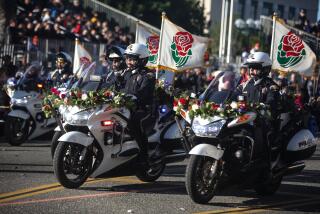Focus: SDPD puts ‘The Wrap’ on struggling suspects
When fists and feet are flying and several cops pile onto a struggling suspect to subdue him, more often they are calling for “The Wrap.”
The stiff nylon blanket is wrapped around a person’s legs and strapped in place to keep him or her from kicking.
A chest harness holds their handcuffed hands in place and keeps them sitting upright, so they can breathe easily.
The Wrap is becoming more popular among San Diego County police agencies and gradually replacing the decades-old “maximum restraint,” or hogtie system. That involves cuffing wrists and wrapping the ankles with a hobble strap that then connects to the handcuffs while the prisoner lies face-down, knees bent.
That position has been linked nationwide with suffocation deaths, especially where the prisoner is overweight, highly intoxicated or under the influence of drugs that can harm the heart or brain.
The San Diego Police Department initially acquired 10 Wraps from maker Safe Restraints, Inc. in Walnut Creek about six months ago, but now has 50.
“The Wrap is more effective and there is no getting out of it,” said San Diego police Lt. Scott Wahl. “It is safer for officers and for people who are combative.”
He said putting on The Wrap is much faster to deploy, and takes fewer officers than old-style maximum restraints.
“You’ve got to get them to bend at the knees,” Wahl said of the hogtie system. “It can be a tough fight.”
A very strong man can often loosen the strap linking hands and feet, and perhaps start kicking out a patrol car window, Wahl said.
Chula Vista, La Mesa and Oceanside and area community college police have been using The Wrap. The Sheriff’s Department detentions unit and San Diego Harbor Police are studying them.
“Since we’ve implemented The Wrap, to my knowledge we haven’t used the old system,” said Chula Vista police Lt. Dan Peak, who runs use-of-force training. His department bought 20 last year, training every sworn officer in their use and getting them in the field in July.
In Oceanside, police Lt. Adam Knowland said his agency started using The Wrap three or four months ago, and finds them “extremely effective.” Half a dozen supervisors carry them in their patrol cars.
“We only use it when someone is actively resisting,” Knowland said. “The majority of our use of force is on people under the influence of drugs or having a mental episode.”
The Wrap was invented by a pair of Walnut Creek Police Department supervisors, Craig Zamolo and Ron O’Dell, 20 years ago. Now retired, they founded Safe Restraints, Inc., and had The Wrap manufactured by a Las Vegas company.
“Prisoners were dying based on the hogtie position after a violent struggle,” said Zamolo, an expert on police use of force and in-custody deaths. “Placing people in that posture impacts their ability to breathe deeply. We were looking for a solution.”
Such deaths often prompt lawsuits by surviving family and end in expensive settlements.
The medical science behind hogtie suffocation deaths, called positional asphyxia, has generated some controversy over the decades. UC San Diego Medical Center researchers studied the blood-oxygen flow in athlete volunteers who were hogtied and found no reduction in oxygen to the brain.
Zamolo said the study failed to distinguish between healthy young men and drug addicts with chronic health problems.
He said the product has never been the subject of a wrongful death or injury lawsuit, or been the documented cause of any injury or death.
The device has evolved from a solid nylon blanket stiffened with steel rods to a cooler nylon mesh. Straps were switched from fabric fasteners that would catch onto dirt or other fabrics to essentially a car seat belt.
The chest harness was invented later, based on ideas from officers using the blanket but finding that a person could still wiggle out of it, Zamolo said.
He said, too, that a benefit to getting a suspect under full control faster is that paramedics can be brought in more quickly to render any needed medical aid.
Three officers typically carry the restrained person by the biceps and leg wrap handles to get them into a patrol car, seated sideways with legs straight across the seat, or onto an ambulance gurney.
The leg restraint, chest harness and separate ankle and wrist straps are stored in a brightly labeled duffel bag. Each kit sells for about $1,100.
Chula Vista police Lt. Peak said he believes use of The Wrap will take off nationwide, and become — like the Taser electronic dart device — a commonly recognized tool.
Zamolo said his company has sold the Wrap to 400 law agencies across the United States, including juvenile facilities. Most of its customers are in northern and central California where company focused marketing efforts.
Only in the past few years, he said, has the company started reaching out to Southern California policing agencies. They send trainers out to show police department instructors how to use the devices.
“(Police) agencies looking for tools to make their jobs safer are always wanting to look at new technologies,” Zamolo said.
More to Read
Sign up for Essential California
The most important California stories and recommendations in your inbox every morning.
You may occasionally receive promotional content from the Los Angeles Times.











